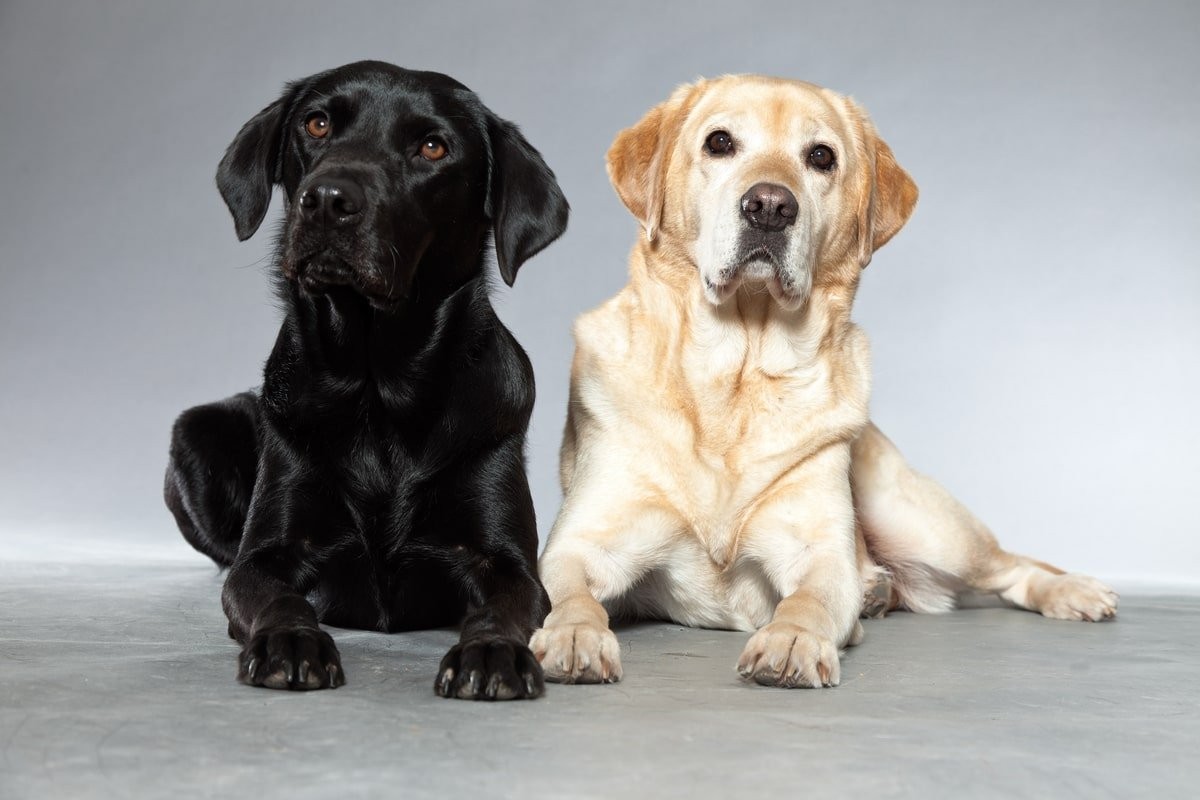Labrador Retrievers are a popular choice for guide dogs, but you’ll often see black or yellow Labs in this role. This leads to the question: Can Chocolate Labs Be Guide Dogs? The answer is yes, but their presence is less common due to genetics and breeding practices. While less frequently seen, chocolate Labs possess the same inherent capabilities as their black and yellow counterparts.
Are Chocolate Labs Excluded from Guide Dog Programs?
It’s a misconception that chocolate Labs are excluded from guide dog service. The reality is that they are less frequently chosen, primarily due to their lower prevalence within the Labrador population. Major guide dog organizations like Guide Dogs of America, Guide Dogs for the Blind, and Southeastern Guide Dogs breed Labradors, prioritizing temperament and health over coat color. These organizations focus on breeding dogs best suited for the demanding role of guiding the visually impaired.
 Black and yellow Labrador Retrievers sitting together
Black and yellow Labrador Retrievers sitting together
Historically, guide dog breeding programs have emphasized factors like:
- Health: Ensuring the dogs are free from genetic predispositions to diseases that could affect their working life.
- Temperament: Selecting dogs with calm, trainable, and people-oriented personalities.
- Size: Choosing a size that is manageable for the handler and suitable for navigating various environments.
- Coat Type: Opting for coat types that are easy to maintain and minimize potential allergens.
- Adaptability: Prioritizing dogs that can easily adapt to different environments and routines.
While coat color isn’t a primary selection criterion, the genetic rarity of the chocolate coat influences the overall number of chocolate Labs in guide dog programs.
The Genetics of Labrador Coat Color
To understand why chocolate Labs are less common as guide dogs, it’s important to delve into the genetics of Labrador coat color. A Lab’s coat color is determined by its genes, much like in humans.
Understanding the Color Genes
A Labrador’s genetic makeup determines its coat color, with the only exception being if two yellow Labs mate, resulting in all yellow offspring. There are three “official” Lab colors, according to the American Kennel Club (AKC): yellow, black, and chocolate.
Genes can be dominant or recessive. In the case of Labrador coat color, there are two types of genes:
-
“B” gene: Dominant “B” results in a black coat, while recessive “b” results in a brown (chocolate) coat. Possible combinations include:
- BB – Black coat
- Bb – Black coat
- bb – Brown coat
-
“E” gene: Dominant “E” allows the expression of black or brown, while recessive “e” overrides black and brown, resulting in a yellow coat.
The genetic combinations and resulting coat colors are as follows:
| Genetic Makeup | Coat Color |
|---|---|
| EEBB | Black |
| EEBb | Black |
| EEbb | Brown |
| EeBB | Black |
| EeBb | Black |
| Eebb | Brown |
| eeBB | Yellow |
| eeBb | Yellow |
| eebb | Yellow |
Probability and Coat Color
The genetic interplay explains why yellow and black Labs are more prevalent than chocolate Labs. Guide dog breeders focus on temperament and health, making it statistically less likely to produce brown puppies, leading to fewer chocolate Lab guide dogs. Even when two chocolate Labs mate, there’s no guarantee all puppies will be chocolate due to the masking (“E/e”) gene.
Why Chocolate Labs Excel as Guide Dogs
When a chocolate Lab puppy is born in a litter, it undergoes the same evaluation and training as any other Labrador Retriever. Chocolate Labs are excellent guide dog candidates due to the breed’s inherent suitability for service work, and coat color doesn’t affect a Lab’s personality.
Labrador Retrievers: Ideal Service Animals
Labradors are exceptionally well-suited to being guide dogs. Their size allows handlers to comfortably reach the harness. Their short coat requires minimal grooming, making them suitable for people with allergies.
The most crucial traits are a mild temperament and high intelligence. With enough variation, Labs can meet the needs of individuals who require service animals.
Dispelling Myths About Chocolate Labs
There’s a misconception about the behavior of chocolate Labs. Research has disproven the notion that they are less intelligent or more aggressive than black or yellow Labs.
Studies show behavioral or physical variations are related to whether they were “working dogs” versus “show dogs,” not coat color. All Labs, regardless of color, are versatile working dogs, eager to please, and highly intelligent. Labs excel in roles such as guiding the blind, search and rescue, and therapy work.
Conclusion
Chocolate Labs are suitable guide dogs despite being less common than black or yellow Labs. The Labrador Retriever is the most popular guide dog breed, but the rarity of chocolate Labs can raise questions about their capabilities. Genetics and breeding practices explain the lower number of chocolate Lab service dogs. All Labs, irrespective of coat color, possess individual traits and personalities, but no differences in character or aptitude stem from coat color.

